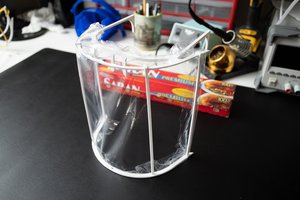This is licensed under the Creative Commons - Attribution license.
Using flat triangular shapes you can construct a geodesic dome. As the theme of the piece this was originally used to create was the un-realised promises of utopian architecture we tried to include or ehnace the inherrent manuacturing features and flaws of FDM type 3d printing such as curling, build platform surface texture, bits of torn kapton stuck in the first layer, residual colours from other prints, visible infill patterns, gaps, printed surface texture etc... which is an interesting and unusual request!
The photographs of all the triangles prepared were all printed on the same machine with the same white plastic. The different colours and tones come from various sources including: black marks drawn on the filament to ensure the filament is being drawn into the extruder correctly, pieces of different colour plastic being left on or falling onto the build platform and being incorporated into the print, Kapton tape unintentionally incorporated into the build, white ABS glue used to patch over small tears in the build platform, acetone and white ABS putty used to repair damaged pieces.
A simple geodesic dome can be made with triangles joined edge to edge. In this case 10 equilateral triangles and 30 isosceles triangles. The isosceles triangles form 6 pentagonal pyramids. The equilateral triangles fill in the gaps. The dome will be about 30cm (1 foot) in diameter.
To make it transparent enough to allow the projection to show through to the other side the parts will have to be very thin. The original idea was to use totally flat triangles of 2 or 3 layers thickness which could be assembled like paper craft models. However, these tended to bend when being removed from the build platform, curled up at the corners, were difficult to assemble and were not very strong once assembled!
The design was modified to include the following features:
mouse-ears at apexes to prevent curling
a thick rim around the edges to provide a large bonding area for strength when assembled and resist bending when removed from build platform
angled edges to make for easier assembly, with the angle chosen to ensure the edges meet at the correct angle for assembling pentagons
a triangular cutout giving a thin central region to enhance transparency
Expected print time on a Thing-o-matic is about 20 minutes per piece or 13 hours in total! O_O;
Instructions
These scripts can be used to make individual triangles or single piece, snap and fold together items that you can use to easily make n-gon pyramids. These can be combined to make a full geodesic dome, or some other interesting shapes. The file "2012_05_25-Deans_dome_pentagon_test-3.scad" is the most up-to-date and allows you to make any of the items described easily by setting a few control variables at the top of the file to 0 or 1. Everything is fully commented and should be easy to follow. Please note: If you choose impossible combinations of values (such as a pyramid made of 8 equilateral triangles) openscad will likely crash horribly!
Make your own sized parts:
Download relevant .scad files and modify triangle_length_a and triangle_length_b variables to match the size of the triangle/n-gon pyramid/dome you want to make (if you want to make a functioning dome you will need to keep the provided ratio of triangle lengths, also as a rough guide the dome diameter will be about 3 times the triangle length)
Modify other variables such as rim_t, rim_w, centre_t and number_of_triangles to suit the object you wish to build
Modify mouse_ear_thickness and mouse_ear_radius to suit your printer
Generate .stl file and print your object(s)
Assemble dome from parts:
Download provided or use scad scripts to make your own sized parts
Print 10x equilateral triangles...
 Mark Gaffney
Mark Gaffney
 Russell Munro
Russell Munro
 Connor Yamada
Connor Yamada
 Scott
Scott
 Brian Brocken
Brian Brocken